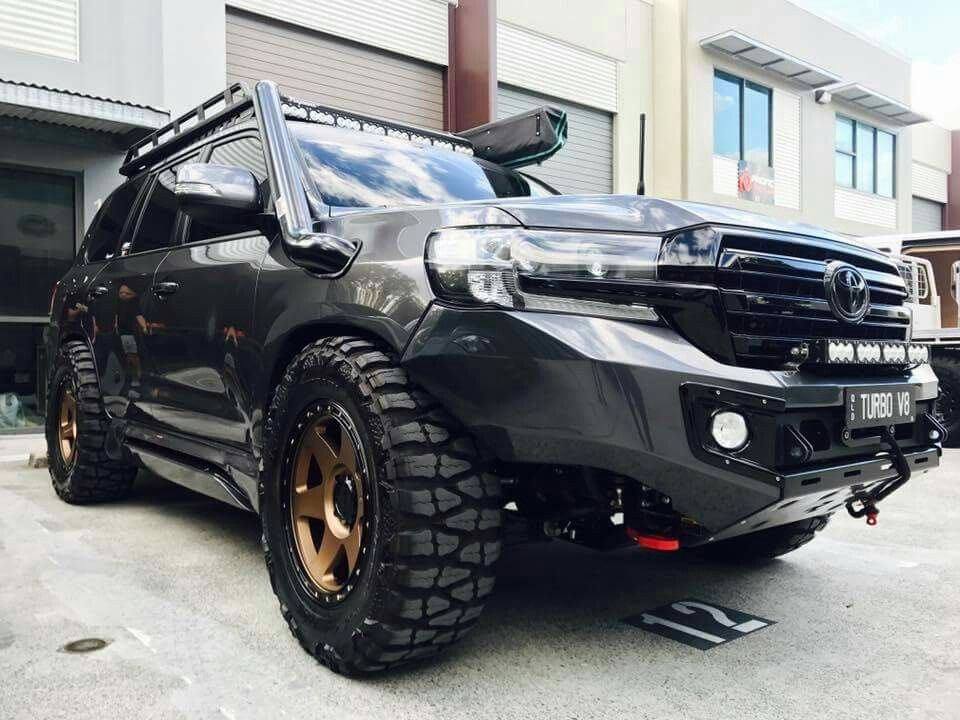Some specifics to add to plenty of good advice already offered:
Tyres: AT tread is good, but ensure you get LT (Light Truck) versions. They are heavier and more expensive, but the right tyre will give you a load rating that ensures you can carry / tow what you want, and not get your side walls sliced by rocks and roots. The minimum load rating to aim for is 120 - check the sidewall, it's on there.
On tyres, even the best tyres aren't much good if you don't run them at the right pressures for the situation. While 4WD-ing, drop pressures to between 22-25 psi to allow the tyres to mould around obstacles. In mud, you might be down around 15 psi. In soft sand, even less. The benefit is also your longer track (tyre contact with ground) with lower pressures - hence greater traction.
The analogy is a balloon - how hard is it to pop a fully inflated one? And how about one that is only half full? Don't forget to re-inflate when you hit bitumen once more.
On the subject of re-inflation - invest in a heavy duty 12V pump that does not sag (in flow volume terms) when the tyre pressure gets up into the 30s. There are plenty of reviews of these and other equipment in your on-line 4WD mags. Aim for a flow rate under load, of around 140 litres per minute or greater.
Monitor your tyre pressures. The best way to do that is with a tyre pressure monitoring system. You will have a constant readout staring at you for each tyre for pressure (and temperature if you so wish). Should you decide to tow a van or camper, these can be bought with six or eight sensors and a read-out module to suit.
Comms - Sat-phone, or at least a UHF CB. The latter needs to be 5 watt output. Don't waste your time with 1W.
PLB - worth every cent of the $300 you will spend. If you're stuck on your own in isolated country it could save your life. The marine version is an EPIRB, the ELT is the aviation equivalent, and the Personal Locator Beacon is what you want.
Suspension - get springs, bushes and shocks upgraded or at least checked out by a reputable shop that deals in 4WDs. Ensure they know the weight (constant load) that you will be travelling with, as this ought to inform their advice to you. If they look at you blankly on this point, run away.
Snorkel - rather than the engine air coming from under the mudguard, how about having it sticking up to where the air is generally clean? Make sure that fit is airtight the whole way down to the airbox though - no leaks.
If your chosen 4WD is a common rail diesel, consider a catch-can to intercept the sludge from the EGR valve, rather than having it clog up your intake manifold (and yes that does happen). Catch-can kits are cheap insurance, and beat removing the manifold from the engine to clean it out.
Recovery gear - a winch is good, but you'll need to consider a long handled shovel, straps (round trees), shackles and even a pulley block to go with it. Needless to say, all of these items should be rated - aim for 8,000 or 9,000 lbs on each. Never pull off a tow-ball - they snap and become lethal cannon-balls.
Consider also a limited slip diff, at least for the rear axle. It may mean the difference between driving out and a laborious recovery.
Off-grid, you'll likely also want a solar panel array. Choices are a fixed panel on the roof, or a variety of available folding panels. The advantages of the latter are that it's portable, and that you don't need to park your 4WD in the sun to charge batteries. CAVEAT - being portable means they will walk if someone likes them more than you do - keep your eye on them.
Batteries - get a deep discharge 2nd battery, and of a size that will cater for your consumption for the time you intend to camp without power. Have it connected to your starter battery with a DCDC controller so that your 4WD alternator charges both batteries, and so that the solar panel/s can also act as a charging source for your vehicle.
Edits - typos.
Disclaimer - no I don't have shares in a 4WD accessory business!





